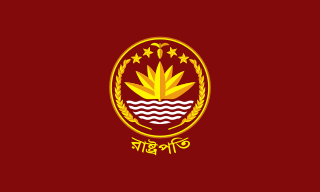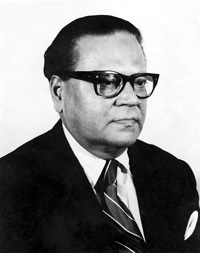Muhammad Rahmatullah | |
|---|---|
মোহাম্মদ রহমত উললাহ | |
 Young Ullah | |
| Chief Engineer Public Works Department | |
| In office 1986–1988 | |
| President | Hussain Muhammad Ershad |
| Prime Minister | Khaleda Zia |
| Chairman Capital Development Authority | |
| In office 1989–1992 | |
| President | Hussain Muhammad Ershad |
| Personal details | |
| Born | June 13, 1940 |
| Alma mater | Bangladesh University of Engineering and Technology |
| Occupation | Engineer |
Mian Muhammad Rahmatullah, (Bengali : মোহাম্মদ রহমত উললাহ, 13 June 1940 – 2014) was a former East Pakistani and later Bangladeshi bureaucrat and politician. He was the former Chief Engineer of the Public Works Department and later the chairman of the Capital Development Authority of the Government of Bangladesh. In 2000, he was an electoral candidate from Natore Area for the Parliament of Bangladesh. [1]

Bengali, also known by its endonym Bangla, is an Indo-Aryan language primarily spoken by the Bengalis in South Asia. It is the official and most widely spoken language of Bangladesh and second most widely spoken of the 22 scheduled languages of India, behind Hindi. In 2015, 160 million speakers were reported for Bangladesh, and the 2011 Indian census counted another 100 million.

East Pakistan was the eastern provincial wing of Pakistan between 1955 and 1971, covering the territory of the modern country Bangladesh. Its land borders were with India and Myanmar, with a coastline on the Bay of Bengal.
A bureaucrat is a member of a bureaucracy and can compose the administration of any organization of any size, although the term usually connotes someone within an institution of government.
Contents
- Early life and education
- Career
- Charges
- Cases
- Implications
- Family, later life and political career
- See also
- References
- Further reading
In 1991, after former military dictator General Ershad stepped down as the President of Bangladesh, Rahmatullah was charged in the infamous Janata Tower Case and named the third defendant after the President and the former First Lady (and Member of Parliament) by the Supreme Court of Bangladesh. [2] [3] He was later acquitted when the judge agreed that the case was filed on political grounds by the newly elected ruling party. [4]

Hussain Muhammad Ershad is a former Bangladeshi Army Chief and politician who served as the President of Bangladesh from 1983 to 1990, a time many consider to have been a military dictatorship.

The President of Bangladesh is the Head of State of Bangladesh.
The Janata Tower Case was a corruption case in Bangladesh over Janata tower in Karwan Bazar in Dhaka. The case lead to the conviction of former military dictator H. M. Ershad.
He was the husband of Gole Afroz of the aristocratic Singranatore Family; the grand daughter of Jalaluddin Mirza, a Zamindar of Natore and was instrumental in building the Gole Afroz College which was named after his wife. [5]

Gole Afroz was a Bangladeshi socialite and member of the Singranatore family, the wife of politician M. M. Rahmat Ullah. She was the eldest daughter of Gulbadan Begum of Natore who was the eldest child of Jalaluddin Mirza and her husband Shamez Uddin Ahmed.

Sahibzada Mīrzā Mu'hammad Jalāl ud-Dīn Mridha Sahib, better known as Jalaluddin Mirza (1898-1975), was a Bengali Indian aristocrat in the erstwhile British Empire who served as the fifth and last hereditary Zamindar of Natore from the House of Singra and Natore before it was abolished in 1951.

Zamindars of Natore were influential aristocratic Bengali Zamindars, who owned large estates in what is today Natore District in Bangladesh.













